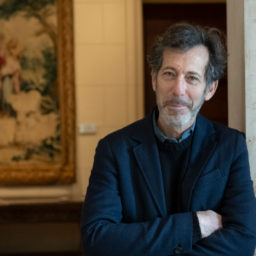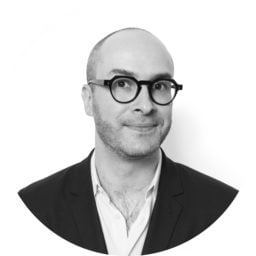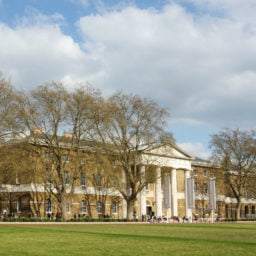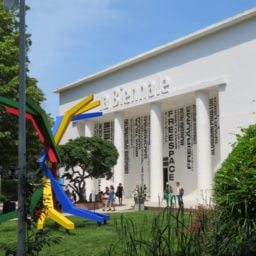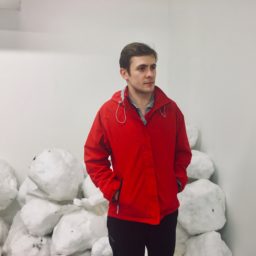This idea that “art is a lie that tells the truth,” to cite a possibly apocryphal quote attributed to Picasso, is a pretty widely accepted concept. Yet that paradox seems to lie at the heart of “May You Live in Interesting Times,” the upcoming Venice Biennale curated by Ralph Rugoff as a master class on the ambivalent nature of art—and of reality itself in our current world of “alternative facts,” where truth is partisan, uncertainty reigns, and logjams over fundamental verities (where “it all cuts both ways,” as Raskolnikov says) makes it possible for amoral figures to seize power.
It’s a dizzying moment, but one that Rugoff—a former journalist and native New Yorker who currently runs London’s Hayward Gallery—is primed to approach, having specialized in shows (like his 2012 survey of “Invisible Art”) that foist a perplexing situation on the audience and force them to contend with it. To that end, he has assembled a group of some 79 living artists and collectives who constitute a broad array of perspectives and approaches, and has asked them to create two separate displays of their work across the Giardini and Arsenale (which he calls “Proposition A” and “Proposition B”), with the aim that they present entirely different views of their work.
Mao, in his rise to power, is supposed to have said, “There is great chaos under heaven; the situation is excellent.” Can such chaos create an excellent Venice Biennale as well? To better understand the aims of this 58th edition of the international show, artnet News’s Andrew Goldstein spoke to Rugoff about the ideas animating his exhibition.
It seems like there are two sides to your biennial. On one hand, you have argued that there is no theme, and that you’re engaging with contemporary art through a strictly formal conceit of a two-part biennial, where each artist presents very different work in both the Giardini and the Arsenale. On the the other hand, as telegraphed by the show’s title and its oft-reported subject, you are tackling the fake-news era and the slippery nature of truth in the world today. Taken together, it seems that the real subject of your biennale is ambiguity itself, and the challenge of how to apprehend things that cut both ways. Given that the Venice Biennale is viewed as something of a State of the Union when it comes to the direction of contemporary art, why do you feel this idea of ambiguity, of multivalence, is such a relevant theme to tackle in 2019?
Precisely because in so many other parts of our society and culture, information can only mean one thing. We’re getting narrower and narrower platforms for any kind of public exchange—it’s this famous siloing of news. We process information in two different styles: we have a very rapid, intuitive style and a more analytical and considered style. Behavioral economists have studied this, and they find that, in contrast to classical economic theory, which talks about a rational homo economicus, most decisions are actually made completely irrationally—they are made out of greed and fear. We have seen this in elections.
Demagogues, like Trump, prey on fear and anger to rile people up and put them in a powerful emotional state, where they feel there is a clear answer to everything. This is what the fiction of Trump’s wall is all about: “Here’s a concrete symbol that will solve all your problems—you don’t have to deal with all the complex issues around immigration.”
The idea that everything is connected is another theme that comes up in this biennale. This is something that Leonardo talked about, so did Lenin, so did [American biologist] Barry Commoner. We live in a world where, because of the internet but even more because of global warming, we have to face the fact that everything is connected. When there’s a bad day of pollution in Beijing, four days later it hits central California. If Europe has an immigration crisis, perhaps is has something to do with former colonial powers creating wars in the Middle East that create these displaced people.
So I guess what I’m looking at is a failure in most of our public discourse to deal with complexity. One project in the biennale, for instance, is a piece by Kahlil Joseph called BLKNWS, in which he’s come up with a conceptual-art interpretation of what meaningful news might be. It focuses on African American life and uses all kinds of found footage from different sources, music, and some of his own interviews. It’s not about information in the sense of CNN soundbites, but is very much about the texture of facts and histories. Although it’s an artist’s project, Kahlil would eventually like to see this on HBO or other television, and it would be great if it eventually gets there. But at this point in time, the place where it can exist is within the art world.
There’s an expression that a genius is someone who can hold two ideas in their mind at the same time, but there’s also the example of schizophrenia, of two simultaneously held ideas being the mark of insanity. Just look at Trump’s “both sides” comments after Charlottesville. The biennale is coming at a time when society is in the throes of this kind of craziness—you look at Brexit, and its clear that Britain can’t reconcile its opposing views of globalization and the rising tide of immigration. It seems to me that so many of the lies that we are hearing from politicians are an attempt to paper over the fact that there is this conflict over identity, immigration, and globalism. How do globalism and identity figure into this biennale?
There’s not a lot of work that deals with national identity, but you will see work that deals with the way that we only look at part of the world. We all do this: people who live in cities don’t really want to deal with homeless people, so you block them out, and through the power of denial you live in a world that is perceptually truncated. There are quite a lot of works in the show that look at this kind of everyday social division. These are works that put that reality back in your face, but not in a finger-pointing kind of way.
I’m really not interested in work that is one-dimensional, that’s pushing a particular point of view, that’s trying to expose one truth or another, that’s playing a documentary role. I think art’s role is to raise questions and to encourage people to keep questioning. So that’s why narrow political art is not that interesting—because it’s already reached a conclusion.
There are a lot of pieces about the divisions created by walls, or in the case of Lawrence Abu Hamdan’s work, how walls may no longer be effective barriers because sound surveillance technology allows people to hear everything beyond those walls. There are also works that aim to change the way we think about identity. There are three non-binary artists in this exhibition, and more women than men in this exhibition. But none of that matters unless the work is also complex. You need works that have multiple entry points to get a good conversation going with the general public.
It’s nice to hear that this is an exhibition that will challenge people, that when you go in there you will be presented with questions rather than answers. Would you say that is one of the concepts?
That is one of the concepts of making any exhibition. One definition of artists is that they are people who pay attention—especially to things that the rest of society, for whatever reason, may not be paying attention to. Artists are constantly asking us to hold two things in our heads at the same time. George Orwell’s “doublethink” meant having two contradictory belief systems and accepting both of them. I think that art is not asking you to accept them, just that you entertain these possibilities. What makes art special is that it resists closure.
In physics, you have Heisenberg’s uncertainty principle.
It’s the same thing. A lot of people are very anxious right now about the political situation, and I feel the same way. But that doesn’t mean you want to end up with a lot of art that’s about politics, because as soon as you end up with art that is about something, you end up limiting what that art can really do. You want art that opens up different perspectives on a subject. In journalism, we talk about this all the time: “This is an artist whose work is about this,” or, “The is an artist whose work is about that.” With the really interesting artists, their work sits between categories. And in order to truly understand what they’re doing, you need to understand the assumptions we make every day to define those categories.
This is a question that I find very hard to ask, because it’s kind of hypocritical and sanctimonious, but as a white male curator at this moment in time, how can you ensure that your show will represent the perspectives of this broader world that you’re addressing?
We’re all limited by who we are. People from different backgrounds than mine would have curated something completely different. At the same time, there are probably a range of positions that you can occupy as a white male—they’re not all the same, and I think whatever position I’m in is fairly open to lots of others. To me, what’s interesting about people like [South African photographer] Zanele Muholi and [Japanese artist] Mari Katayama, whose works challenge our conventions, codes, and genres of representing the self, is that their work is so layered. People talk about identity as a performance rather than a hard-and-fast role. There’s a parallel in the way I think about a work of art—it has an open-ended character.
How were you able to encompass this multicultural picture of the world in your show? Did you have any help? Were there any guideposts along the way in your effort to reflect this broader experience?
You know, I’ve been looking at art for a long time. You don’t start from a blank slate to do this—you already have a pretty big inventory of artists you know. And you draw on colleagues, you draw on other artists. For this exhibition, I asked every artist I invited to tell me one other artist they would like to show next to in this biennale. I didn’t necessarily choose every artist who was recommended to me, but I chose some. Some of them were already on my list, some I didn’t know. I wanted the relationships among the artists to work on levels that might not be immediately obvious.
The most important information you get as a curator comes from the artists. There’s also a slightly random element in this process, in that you have a six-month period to do your research, and when you’re in a particular country at a particular time, maybe you discover an artist you never would have encountered otherwise. Fortuitous things happen. So there’s no way in the world that that one person who puts on an exhibition of this scale can pretend it is in any way definitive—it’s all a provisional, contingent take.
One interesting thing you could say about this show is that it’s the millennial biennial, in that it has a very high percentage of artists born after 1980, and even one born after 1990. Is there any kind of commonality that you see across this younger generation?
They have a different understanding of what an image is and how an image functions. When you’re looking at the same image on a lot of different platforms—social media, the telephone, the computer—it takes on different characteristics, right? More and more, there’s a sense of the image not just as a form of representation but also as an interface where different cultural forces are played out. An older generation might see the image as a depiction and miss out on this other approach.
One thing that is very much prevalent among the younger generation is a hunger for in-person “experiences,” given the amount of time that they spend on screens. I know you worked with an architect to create new flows and new structures within the biennale itself. Was this notion of “experiences” that people can photograph something you were thinking about when putting together the show?
Social media is a two-sided coin in terms of how people experience exhibitions. On the one hand, yes, it helps spread the word so that people who may never know about an exhibition otherwise suddenly see it, think it’s interesting, and go. On the other hand, you have an endless stream of people who see an exhibition as a nice-looking background for their selfie, or who just want to put some interesting images on their social media feed, but don’t really engage with the work beyond that. And that’s obviously a missed opportunity. But hopefully some of those visitors might get interested in what this conversation is about.
What would you say to the selfie-takers who come to see your biennale?
Well, that hopefully they’ll get curious about other things besides their own image.


